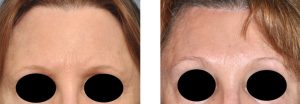Rejuvenation of the upper third of the face is done through a forehead or browlift procedure. Browlift surgery has evolved from the traditional open scalp approach (open browlift OBL) to that of a more limited incision endoscopic browlift (EBL) technique. While there are some reasons in whether one should be used over the other, these two browlift methods also differ by their after surgery effects.
Besides potential differences in results and in the size of the incisions, they also have differences in forehead and scalp feeling afterwards. Open browlifts (OBL) definitely result in more early forehead and scalp numbness than endoscopic browlifts. (EBL) This makes perfect sense and can be predicted because of the incision length differences. While both techniques manipulate the supraorbital and supratrochlear nerves at the brow bone level through removal of enveloping muscle tissue, the differences are in the number of terminal nerve ends cut at the level of the scalp incisions.
In a recent study published in a Facial Plastic Surgery journal, a prospective study of patients undergoing OBL and EBL was done to compare objective and subjective loss of forehead and scalp sensation at various after surgery time points.The study found, not surprisingly, that the OBL group had significantly greater objective loss of feeling during the first month after surgery and greater subjective sensory loss at three months. These differences were no longer present at six months after surgery. They observed that one to two weeks after OBL or EBL, all individuals will experience significant subjective and objective numbness of both their forehead and scalp. However, despite that the scalps of those undergoing OBL were objectively more insensate than of those undergoing EBL, those undergoing OBL did not necessarily feel more forehead or scalp numbness than those in the EBL group by eighteen months after surgery.

Dr. Barry Eppley
Indianapolis Indiana


